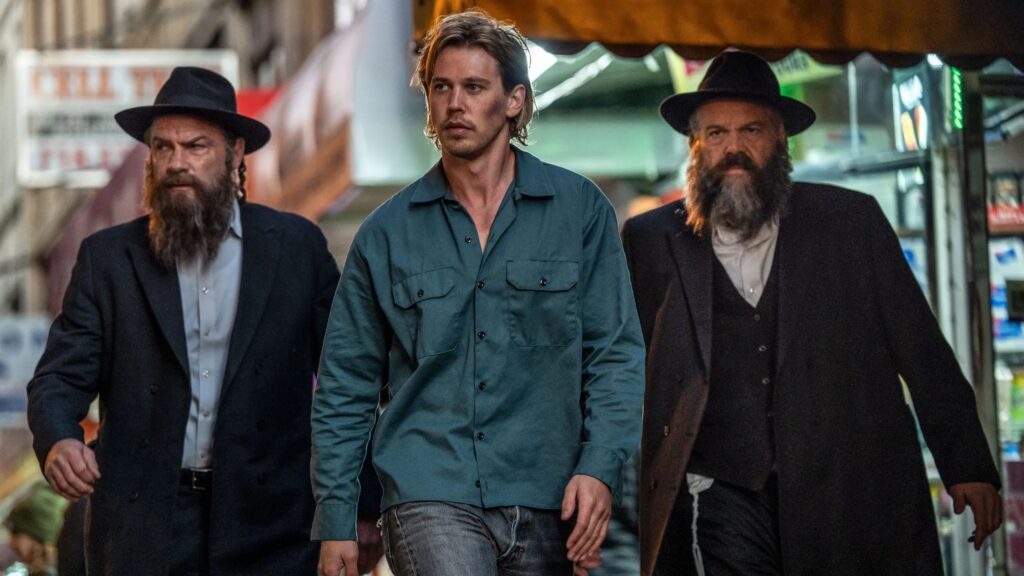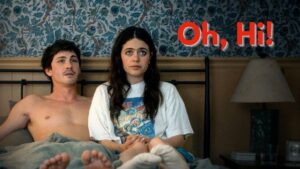Quick Facts
Title: Caught Stealing (2025).
Director & Producer: Darren Aronofsky.
Screenplay: Charlie Huston (based on his novel Caught Stealing).
Music: Rob Simonsen, score recorded with the British post-punk band Idles.
Runtime: 107 minutes.
Budget: $40 million.
Genre: Dark comedy / crime thriller, set in the 1990s NYC underworld.
Cast — Who’s in It & How Many Main Players.
The film boasts a sizable ensemble, mixing big names and character actors. Some of the principal cast:
- Austin Butler as Hank Thompson, the former high school baseball phenom-turned bartender (the main character).
- Zoë Kravitz as Yvonne, Hank’s girlfriend.
- Matt Smith as Russ, the punk-rock neighbor whose cat Hank agrees to look after.
- Regina King as Roman (a perceptive cop).
- Liev Schreiber as Lipa.
- Vincent D’Onofrio as Shmully.
- Bad Bunny as Colorado.
- Griffin Dunne as Paul.
- Carol Kane as Bubbe.
- Also: D’Pharaoh Woon-A-Tai (Dale), Will Brill, George Abud, Yuri Kolokolnikov, Nikita Kukushkin, Action Bronson, among others.
In total, counting major supporting roles, there are around 15-20 credited characters with meaningful screen time.
Who is the Main Character / “Means Character of Caught Stealing”
That would be Hank Thompson (played by Austin Butler). Everything revolves around him:
- He carries the emotional burden (of a failed baseball career, regrets, possibly addiction) and is the one whose life spirals when a small favor (pet sitting a cat) drags him into danger.
- We follow the story through his efforts to understand what’s happening, evade threats, reconcile his past, and stay alive. The supporting cast intersect with his arc, but he remains the viewpoint, the one we are meant to root for (despite his flaws).
So the story is fundamentally Hank’s.
Box Office & Financial Performance (“Means Box Collection”)
Here are the numbers and performance metrics:
- Domestic (U.S.) gross: ~$18.35 million
- International gross: ~ $9.4 million
- Worldwide total gross: ~$27.75 million
- Opening weekend (domestic): ~$7.80 million from 3,578 theaters, which was about 42.5% of the domestic gross. The Numbers
Given the budget was $40 million, the theatrical box office is underperforming relative to cost when one considers marketing, distribution, etc. The film did not “recoup” on theatrical alone in most estimates.
Critical reviews are generally positive, with praise for the performances (especially Butler) and Aronofsky’s direction, though commentary about tone and coherence is mixed.
So financial “box collection” is modest / underwhelming compared to the budget, though it may generate further revenue through streaming, VOD, etc.
The Niche / What kind of film is Caught Stealing
Caught Stealing occupies a crossover niche: crime thriller + dark comedy + character-drama. Some key attributes that define its niche:
- “Everyman caught in over-his-head” crime thriller: A protagonist with flaws, modest life, drawn unintentionally into criminal conflict; reminiscent of many noir / crime films where normal life crashes into the underworld.
- 1990s New York backdrop: It uses nostalgia, period detail, grit; setting in the late-’90s NYC gives both stylistic context and a space where technology, culture, criminal enterprises had different constraints (pre-digital dominance).
- Ensemble cast of morally grey characters: Gangsters, criminals, cops, neighbors, all complex: not pure evil, often with exceptional weirdness, conflict.
- Dark humor mixed with violence: It doesn’t treat everything as grim; some scenes lean comedic, absurd, or satirical, often in how ordinary Hank is forced to deal with absurd levels of danger.
- Novel adaptation: Based on Charlie Huston’s novel; fans of gritty crime lit get some of the flavor of book-crime, layered characters.
Thus Caught Stealing is aimed at audiences who like crime thrillers but not purely violent blockbusters — people who want character, weirdness, tension, style, some moral ambiguity, and a bit of an unpredictable ride.

Deep Details — Story, Themes, What Works, What Doesn’t.
Plot (spoiler-light summary)
Hank Thompson is a former high-school baseball star whose athletic career ended (for reasons gradually revealed). Now he bartends in New York, is trying to live a relatively normal life. He’s with a girlfriend, Yvonne (Zoë Kravitz), and seems content to stay out of trouble. Then his neighbor Russ (Matt Smith) asks him to look after his cat for a few days.
That seemingly innocent favor quickly spirals: Hank is attacked (mistaken identity or guilt by association) by Russian gangsters, involves himself in criminal entanglements he doesn’t understand, and must piece together why people are after him, what Russ owes, just how dangerous things are. Meanwhile, he is also dealing with his own regrets (baseball, what his life “should have been”), grief, possible alcohol use.
Supporting threats include Lipa (Liev Schreiber) and Shmully (Vincent D’Onofrio), two tough/criminal figures, plus others who complicate Hank’s attempts at escape or truth. The police, represented by Regina King, complicate matters: not purely helpers, but figure in morally ambiguous ways.
The film builds tension via escalating stakes: from injury, to debt, betrayal, and the sense that Hank does not understand the rules of this underworld. There are moments of violence, chaotic action, moral ambivalence. Eventually Hank must confront his past (what ended his baseball hopes), reconcile with Yvonne, face up to responsibility (for Russ’s situation or for his own choices), and try to survive physically and psychologically.
Themes & Motifs
1. Regret, lost potential, identity
Hank’s past as a promising baseball player is a heavy echo: what might have been, what he feels he lost. His identity is partially wrapped in “former” versions of himself, in shame, in comparison. The film uses flashbacks (or hints) to show how sports, youth, mistakes shaped him.
2. Survival & deception
A large part of the story is about what one must do to survive when one doesn’t understand all the dangers. Deception, misdirection, hiding things from others (including oneself), become survival strategies. Hank lies to Yvonne sometimes, to Russ’s associates, etc.
3. Chaos of minor decisions
One of the major calls of the plot is that a small, well-meaning act (pet-sitting) becomes huge trouble. The film explores how minor decisions, guilt, debt, hidden associations can entangle someone even if they try to stay “out of it.”
4. Moral ambiguity & shades of villainy
Characters who are criminals are not always one-dimensional. There are moments of humanity. Police are not always purely righteous. Hank is not purely heroic. The film tends to avoid pure black-and-white morality.
5. Violence + dark humor
The film doesn’t just punish; sometimes it leans into absurdity. The juxtaposition of the mundane (bartending, baseball memories, cat-sitting) with gruesome violence helps sustain tension and gives relief.
What Works Strongly
- Performance by Austin Butler — many reviews praise his portrayal of Hank; his emotional vulnerability, the way he carries regret, the physicality of being out of one’s depth.
- Direction by Aronofsky — he brings stylistic energy, visual flair, tension, and a sense of bizarre surrealism meshed with gritty realism. Especially in escalating scenes.
- Ensemble cast — actors like Regina King, Zoë Kravitz, Schreiber, D’Onofrio add texture and help elevate the conflicts. Their presence adds credibility and stakes.
- Setting & period detail — mid/late 90s New York is well evoked: cultural touches (music, phones, fashion), atmosphere. Nostalgia + dangerous city energy works. Critics often note this as one of the film’s strengths.
- Tonal risks — the mix of comedy, violence, moral corners is risky, but where it pays off, it gives the film distinctiveness. The film doesn’t feel like another throw-away crime flick, but something with ambition.
What Doesn’t Work / Where It’s Weak
- Pacing issues / tone shifts — some reviews say the film struggles to maintain a consistent tone: sometimes it’s dark and brutal, sometimes absurd; transitions can feel jarring. For some viewers, that unevenness undermines emotional investment.
- Lack of clarity / overstuffed plot — because there are many characters, subplots (past, debt, betrayals), some viewers felt the film tries to do too much, resulting in under-explored threads or loose ends.
- Commercial underperformance — the box office didn’t match the budget; this may mean that while critics found many positives, general audiences may be less enthusiastic or find it too messy / violent / tonally uneven. Financial return is modest relative to budget.
- Sympathy for the lead — some critics say it’s hard to fully root for Hank at times: his flaws, his passivity, or moments where he seems overwhelmed reduce his agency. While that may be intended, it can also lessen the emotional weight when the film asks audiences to invest in his redemption or survival.
Reception & Criticism
- On Rotten Tomatoes critics generally positive; some highlight good action, surprises, performances; others note uneven tone.
- CinemaScore audience grade is “B” (which indicates decent satisfaction but not overwhelming love).
- Opening was strong: about $7.8 million in its opening weekend, but then dropped significantly in subsequent weeks.
Does Caught Stealing Deliver?
In my view, Caught Stealing largely delivers as a stylized, violent, character-driven crime thriller with heart — though not without flaws.
If you go in expecting a clean, tightly plotted crime movie, you’ll be disappointed; but if you want messy, grit, moral ambiguity, and a protagonist who is flawed and human, you’ll find plenty to like.
The biggest payoffs are in the film’s atmosphere, its lead performance, and its ability to hold some moments of discomfort — but also to surprise you with humor or absurdity. The biggest failures are where it gets overly chaotic, where the stakes feel fuzzy, or where tone shifts pull you out of immersion.
Summary Table of Caught Stealing.
| Element | Snapshot |
|---|---|
| Principal Cast | Austin Butler (Hank), Zoë Kravitz (Yvonne), Matt Smith (Russ), Regina King (Roman), Liev Schreiber, Vincent D’Onofrio, Bad Bunny, Griffin Dunne, Carol Kane, etc. (~15-20 credited roles) |
| Main (“Means”) Character | Hank Thompson (Austin Butler) — the one whose regrets, survival, and unraveling we follow. |
| Budget vs Box Office | ~$40 million budget; ~$27.75 million worldwide gross; opening weekend ~$7.8 million domestic; underperformance versus budget. |
| Niche | Crime thriller / dark comedy; 1990s NYC; “innocent man caught in underworld”; ensemble cast; novel adaptation; morally messy. |
| Strengths | Lead performance; style / direction; atmosphere; period detail; ensemble acting; risky tone. |
| Weaknesses | Tone shifts; plot sometimes overstuffed; underexplored threads; less commercial appeal; variable audience empathy. |
Final Thoughts of Caught Stealing.
Caught Stealing is a worthwhile ride for people who enjoy crime thrillers that don’t pretend everything is clean, heroes are perfect, or evil is simple. It’s messy, loud, violent — but also tender in places, regretful in others. Austin Butler plays a man haunted by what he lost and forced to survive with limited tools; Regina King’s cop adds moral texture; Zoë Kravitz brings authenticity and heart.
The film will likely be remembered more for its ambition, its audacity, and its visuals than for clean storytelling. For Aronofsky fans, it’s a return to more kinetic, jagged work (less somber than The Whale, more chaotic). For genre fans, there are satisfying set pieces, twists, and discomfort.
If I were to recommend it: see it in theater if you can — it’s one of those movies where sound design, tension and crowd reactions help. If not, waiting for streaming is okay — just expect it to be flawed and exciting rather than perfect.





